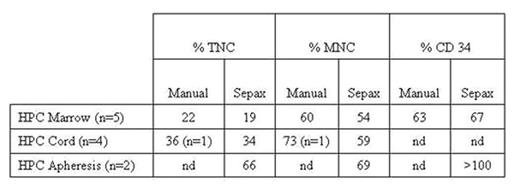Abstract
Mononuclear cell fraction (MNC) enrichment from hematopoietic progenitor cells (HPC) cells is required for a number of clinical applications. Previously, we have used a manual method for enrichment of these cells. We evaluated an automated procedure for better consistency and patient safety (reduce risk of contamination). We have been using the Sepax (BioSafe) for the past 18 months to process Cord Blood (RBC depletion) before cryopreservation. Since the instrument can also do density gradient enrichment of mononuclear cells, we evaluated the ability to process different sources of hematopoietic progenitor cells (HPC) on the Sepax.
Methods: Bone marrow, non-mobilized apheresis and cord blood were evaluated as a source of HPC. Briefly, 100ml of Ficoll solution were added to the chamber of the Sepax disposable. After initiating centrifugation, 50–110 ml of HPC were then overlayed onto the density gradient. The cells were fractionated, mononuclear cell fraction isolated, and then washed three times before final resuspension in 50ml of Saline/5% albumin. In some experiments the HPC were divided into two fractions so that a direct comparison of the Manual vs Automated enrichment procedure could be compared. Finally, a recent publication from Seeger et al (
Results: The total nucleated cell (TNC), MNC and CD34 recoveries after MNC enrichment were similar for either bone marrow or cord blood HPC comparing the manual procedure and the automated procedure. The TNC and MNC recovery was higher for apheresis products (66% and 69% respectively) than the other two sources of HPC. This most likely reflects the enriched MNC starting population from an apheresis device. We evaluated the TNC and MNC recoveries over a range of initial TNC (7.5–20 × 108 cells) but could not see an effect of either cell number or cell concentration on recoveries. Nor could we see an effect of initial cell volume (50–100 mls) on recovery of cells post processing. Finally, we could not see a difference in either TNC or MNC recovery when the four different sources of density gradient solution were compared.
Conclusion: We have shown that the Sepax instrument can be used for enrichment of mononuclear cells from HPC, Marrow, HPC, Apheresis and HPC, Cord. The benefits of an automated system are
consistency,
functionally closed system which reduces possibility of contamination
documentation of run parameters and
shorter processing time.
Author notes
Disclosure:Consultancy: Author JDM has served as a consultant for BioSafe within the past two years.


